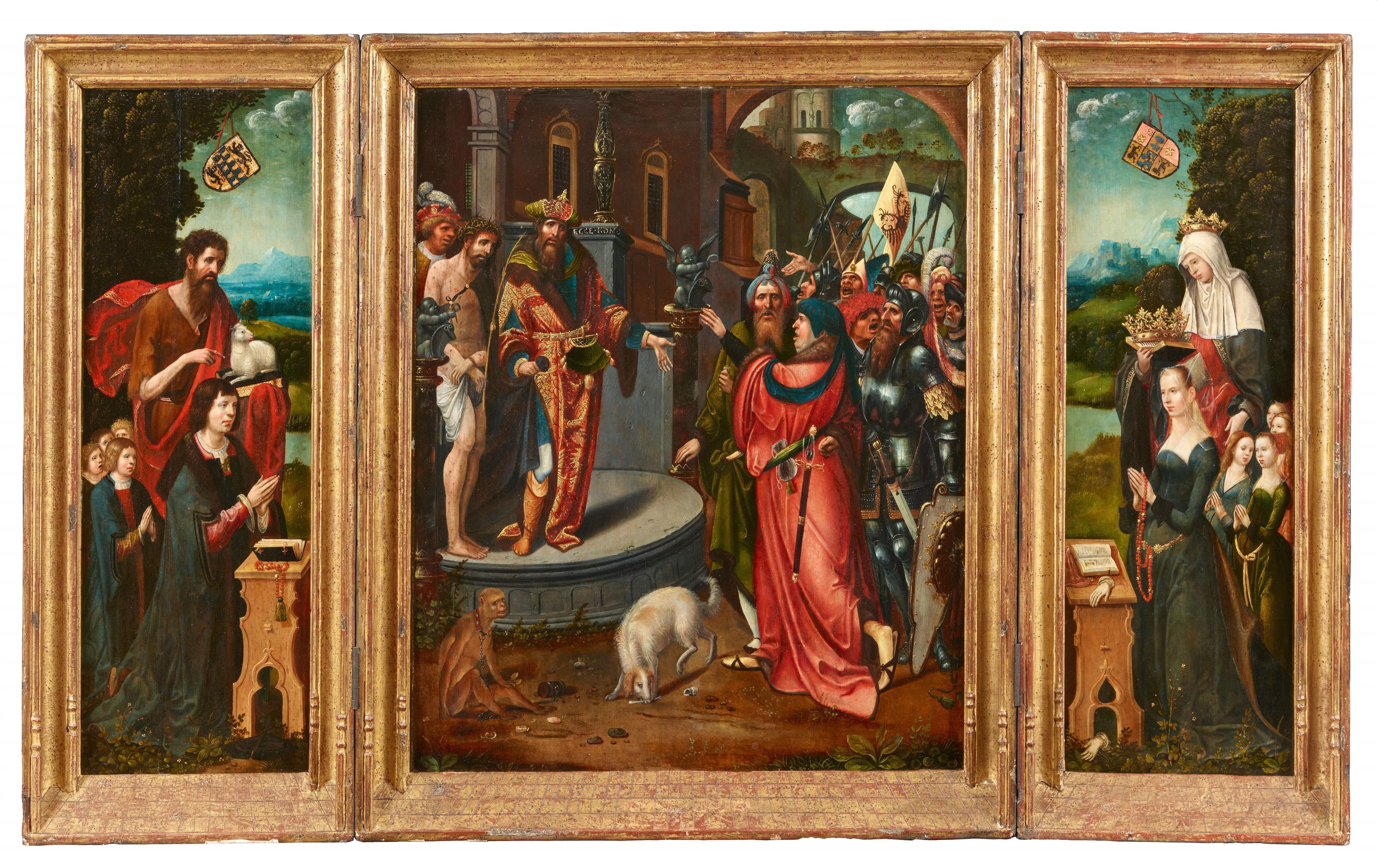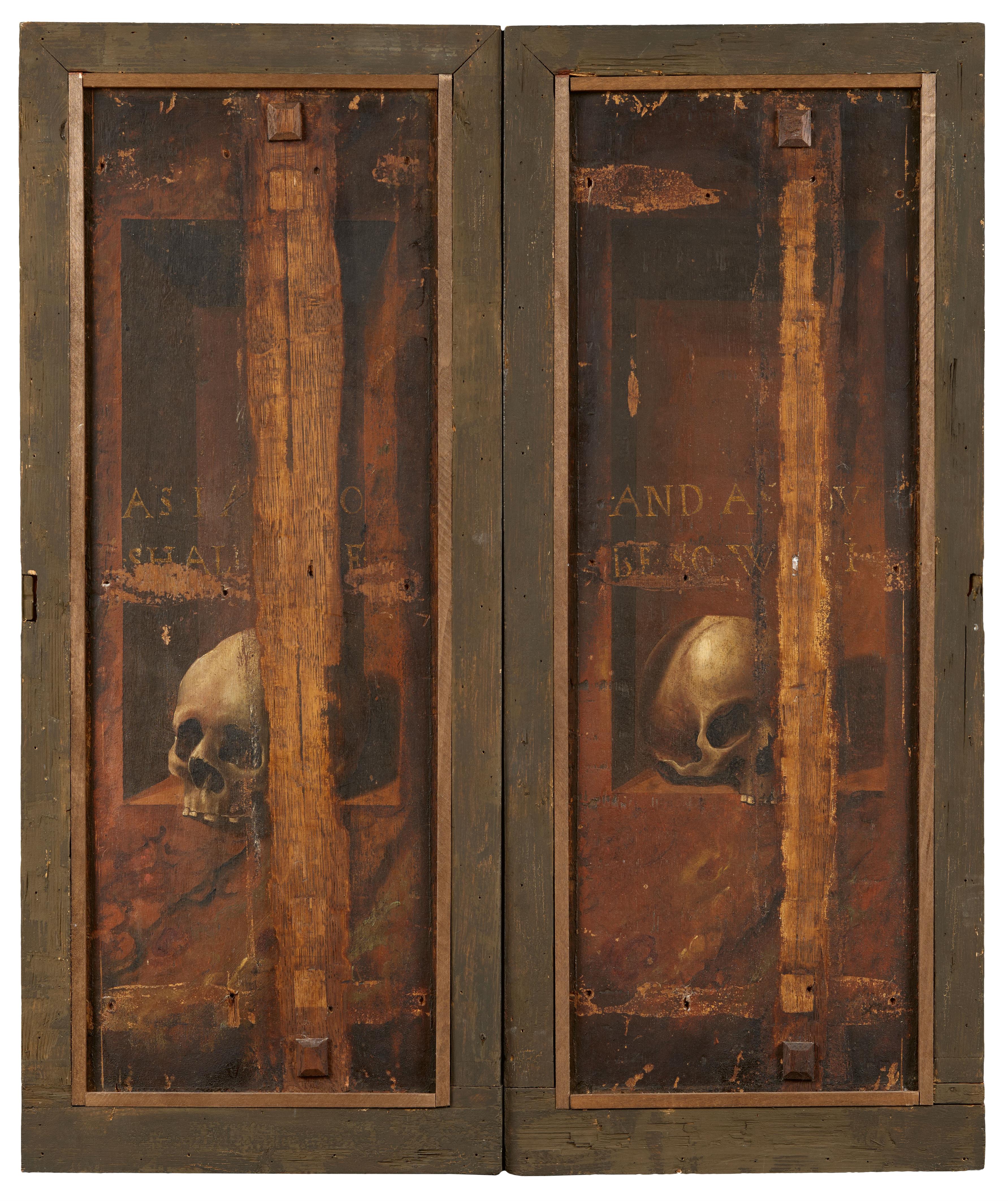Adriaen van Overbeke
Triptych with Ecce Homo
Oil on panel. Central panel 68 x 56 cm. Side panels 58 x 23 cm each.
As I am so shall you be/ And as you be so was I - The inscription and the skulls on the panels remind the viewer to meditate on death and on the transience of all being. But when he opens the two panels, the triptych offers him the promise of redemption and the overcoming of death. He sees a depiction of the Ecce Homo scene, the suffering of Jesus through which men are redeemed, as witnessed by John the Baptist, who can be seen on the right of the altarpiece: Behold the Lamb of God who takes away the sins of the world. Pontius Pilate has come out of his palace to present the scourged Jesus to the people. The words he speaks to the angry crowd are inscribed on the architecture: Ecce Homo, "Behold, a man". Pilate is dressed in a splendid oriental costume, Jesus, on the other hand, wears the crown of thorns and the staff as a mocking sceptre, his head is bowed and his body flayed. High Priest Caiaphas, dressed in red fur-trimmed robes, is highlighted in the crowd that is roaring and slavering for Jesus' death.
When painting this Ecce Homo, Adriaen van Overbeke was able to draw on models by artists working north of the Alps, such as the engravings of Martin Schongauer and Albrecht Dürer. These traditional elements included the view of the city with the palace as the setting for the scene and the elevated positioning of Pontius Pilate and Jesus, but also details such as the monkey and the dog, which also make their appearance in the engravings. Van Overbeke, however, modifies the usual compositional scheme: he does not place Pontius Pilate and Jesus on the palace steps, but rather shows them on a low round pedestal. The protagonists are thus moved closer to the crowd as well as to the viewer, the composition is condensed and the idea of a humiliating display is intensified.
The viewer saw the suffering of Jesus, which gave him hope for salvation. But he also saw - himself, since the intended viewer of this altarpiece was its patron, who had himself and his family depicted on the side panels. The piece was made for the Englishman John Vowell - he can be identified from the coat of arms above him - who had himself portrayed on the dexter side with his patron saint, St. John, and his sons. The figures are depicted against a panoramic landscape that continues across the central panel and opposite side panel and thus connects the three pieces with one another. His wife, with her patron saint, St. Alice, and their two daughters is shown on the other side panel. The eldest son and daughter show similarities to their respective parents, while the younger children do not look quite so serious and seem a little distracted. John Vowell himself and his wife will have knelt before the precious triptych as devoutly as their counterparts on the side panels before the depiction of Ecce Homo. The fact that his patron saint, St. John, according to the theologians, played an important role as intercessor of mankind at the Last Judgement alongside the Mother of God, will have strengthened the certainty in him that one day he would be redeemed.
For John Vowell, this triptych was an investment in his salvation; but he also acquired a modern work of art created in the leading artistic centre of the Netherlands, Antwerp. The delight in storytelling, the use of the city view as a stage, the complex composition, details such as the stone putti adorning the architecture - a decidedly Italian pictorial element - make this altarpiece an exemplary work of early 16th century Antwerp Mannerism, of which Adriaen van Overbeke was one of the leading exponents. This altarpiece for an English patron pays testimony to the pan-European appeal of his art - and of Antwerp as an artistic centre (for more on Adriaen van Overbeke and Antwerp Mannerism see Antwerp/Maastricht 2005/2006: ExtravagAnt! A forgotten chapter of Antwerp painting, 1500-1530, Antwerp 2005).
Provenance
Galerie Claude Vittet, Paris. - Acquired there by the present owner in 2013.




